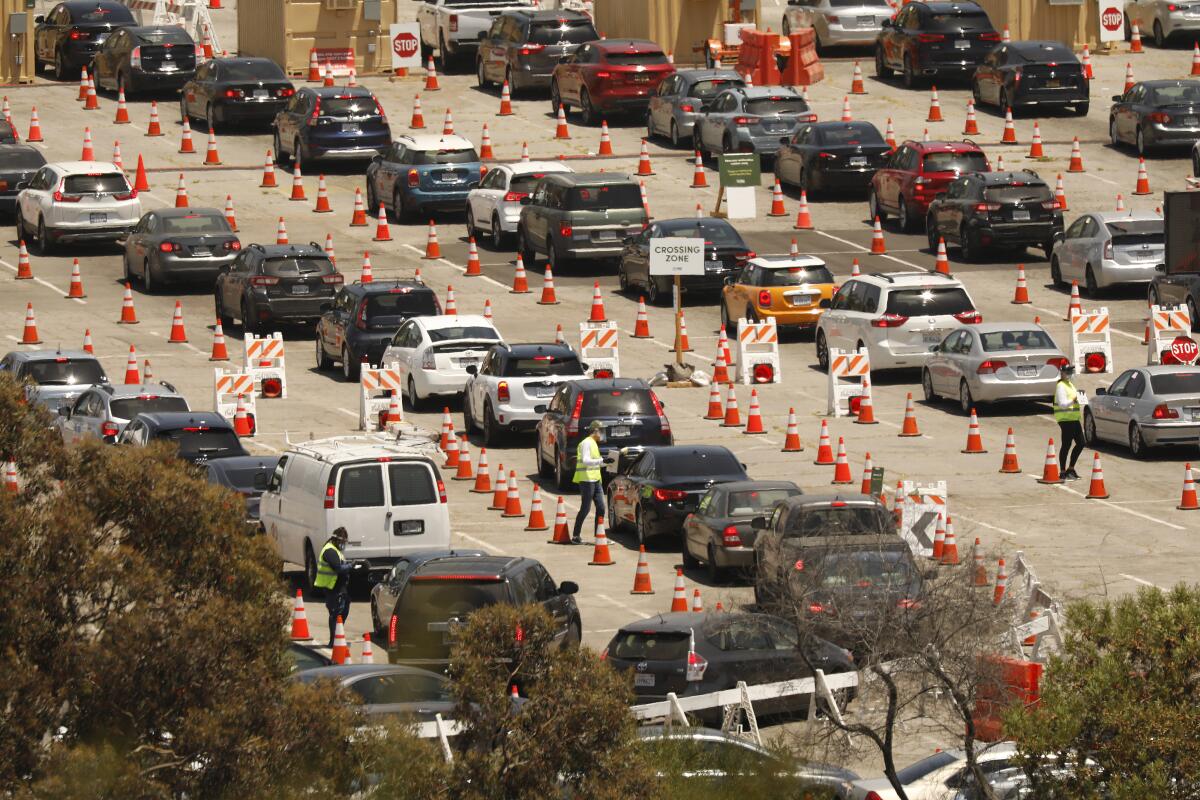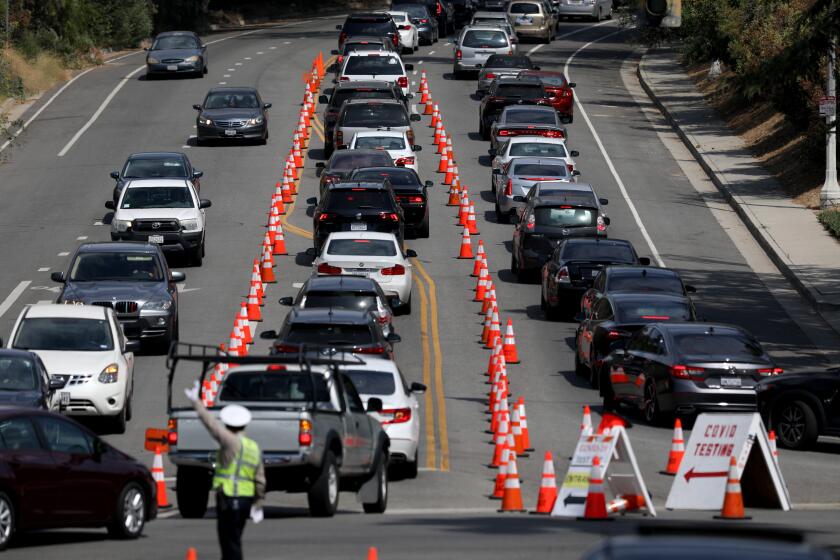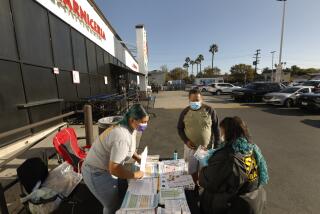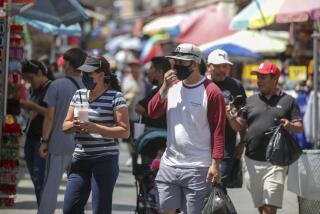L.A. County records highest daily coronavirus death toll in a month

- Share via
Los Angeles County on Wednesday recorded its worst daily coronavirus death toll in at least a month, which may be the result of increased disease transmission that likely began around Memorial Day.
Officials with the Los Angeles County Department of Public Health reported 60 new coronavirus-related deaths Wednesday, and Long Beach — which has its own health officer — reported one new death. The combined total of 61 cases is the highest single-day death toll since June 2, when 62 deaths were reported across L.A. County, according to the Los Angeles Times’ California coronavirus tracker.
“Our cases are rising. The rate of infection is increasing. And the number of hospitalizations are up. And today, we’re even seeing a small increase in the number of deaths,” Barbara Ferrer, the Los Angeles County director of public health, said Wednesday.
“Tragically, we do expect that more of our loved ones and our neighbors may die of COVID-19 in the coming weeks with all of the increases we’re seeing in hospitalizations,” Ferrer said.
“We are seeing a sharp increase in community transmission,” Ferrer added, pointing out that L.A. County is recording on average 2,400 new coronavirus cases a day; at this time in June, L.A. County was tallying about 1,300 cases daily.
California cases are on pace to double every 24.8 days, a number that is used by experts to measure how quickly the virus is spreading.
On Monday, there were 2,004 people hospitalized with confirmed coronavirus infections in L.A. County, a 36% increase from Memorial Day, when 1,477 coronavirus-infected people were in L.A. County hospitals.
Monday was the second consecutive day L.A. County has posted a record number of coronavirus-related hospitalizations since the pandemic hit California.
“This is more people hospitalized each day for COVID-19 than really at any other point in the pandemic,” Ferrer said. “We are worried, given the higher rates of hospitalizations, that deaths may go back up.”
Experts say it can take three to four weeks after exposure to the virus for infected people to become sick enough to be hospitalized, and four to five weeks after exposure for patients to die from the disease.
Statewide, the number of coronavirus-related hospitalizations continued to march upward.
Tuesday marked California’s 18th consecutive day of breaking the record for number of hospitalized people with confirmed coronavirus infections.
On Tuesday, Gov. Gavin Newsom said there were 6,100 people hospitalized with confirmed coronavirus infections, a 114% increase from the number six weeks earlier, on May 26, when 2,847 people were hospitalized.
The number of people in California’s intensive care units has also soared.
On Tuesday, there were 1,753 people with confirmed coronavirus infections in California’s intensive care units, a 71% increase compared to the number six weeks earlier, on May 26, when 1,026 coronavirus-infected patients were in the ICU.
In both Los Angeles County and across the state, a higher percentage of coronavirus test results are coming back positive — an indication that virus transmission is worsening.
The latest maps and charts on the spread of COVID-19 in Los Angeles County, including cases, deaths, closures and restrictions.
The so-called positivity rate has more than doubled since late May in L.A. County. The seven-day average of the daily so-called positivity rate climbed to 10.4%, officials said Wednesday; in late May, that rate fell to a low of 4.6%.
Across California, the rate at which coronavirus tests have come back positive has jumped 67% in the last three weeks.
A Los Angeles Times analysis of test results Wednesday showed the statewide positivity rate over the past seven days was 7.7%%; three weeks earlier, the rate was just 4.6%.
There were some signs of progress — and that warnings the pandemic was worsening in L.A. County in recent weeks may be working.
Over the three-day Fourth of July weekend, out of 1,101 restaurants inspected in L.A. County, 99% were in compliance with county orders to provide only outdoor dining, takeout or delivery; 99% of customers were wearing masks and 82% of employees were wearing appropriate face coverings.
Of 82 bars that were visited by L.A. County inspectors, all were closed, complying with an order issued last week.
By contrast, half of 2,000 restaurants inspected on a mid-June weekend were not in compliance with safety guidelines.
In addition, while coronavirus-related hospitalizations are at all-time highs in L.A. County, they’re increasing at a slower rate, said Dr. Christine Ghaly, L.A. County’s director of health services.
L.A. County officials began sounding the alarm a month ago, when the effective transmission rate of the coronavirus rose above 1, meaning for every one person infected with the coronavirus, that person on average transmitted the virus to more than one other person — setting the stage for a dramatic worsening of the pandemic.
The transmission rate has fallen back to 1 in recent weeks. That’s good news, and if that rate remains steady, it’s now likely that L.A. County will have an adequate supply of hospital beds through early August.
But because the rate was above 1 for a period of time in June, it also means that as we head into July, L.A. County is now dealing with the consequences, Ghaly said.
Ghaly said officials suspect that the reopening of L.A. County’s economy was the major reason for the uptick in transmission.
L.A. County reopened churches and in-store shopping on May 26; allowed indoor dining to resume on May 29; and permitted bars and wineries to reopen on June 19.
Bars were ordered closed in L.A. County on June 28, and indoor dining was ordered closed on July 1.
The coronavirus continues to disproportionately impact Black and Latino residents of Los Angeles County compared to white residents, according to an age-adjusted analysis of mortality rates released by county officials.
Black and Latino residents of L.A. County are dying at roughly double the rate of white residents, the analysis found.
For every 100,000 Latino residents, 45 have died; and for every 100,000 Black residents, 41 have died.
For every 100,000 Asian residents, 27 have died. And for every 100,000 white residents, 21 have died.
The overall mortality rate in L.A. County is 33 deaths for every 100,000 residents.
The racial disparities are a cause of concern, Ferrer said, and mean that officials need to redouble efforts to improve access to testing and healthcare in underserved areas, as well as help workers who may not have adequate protection on the job.
Poor neighborhoods are also showing far worse mortality rates. Those living in areas with the worst poverty in L.A. County are seeing 73 fatalities for every 100,000 residents, while residents of the wealthiest areas are seeing 18 deaths for every 100,000 residents.
More to Read
Sign up for Essential California
The most important California stories and recommendations in your inbox every morning.
You may occasionally receive promotional content from the Los Angeles Times.















